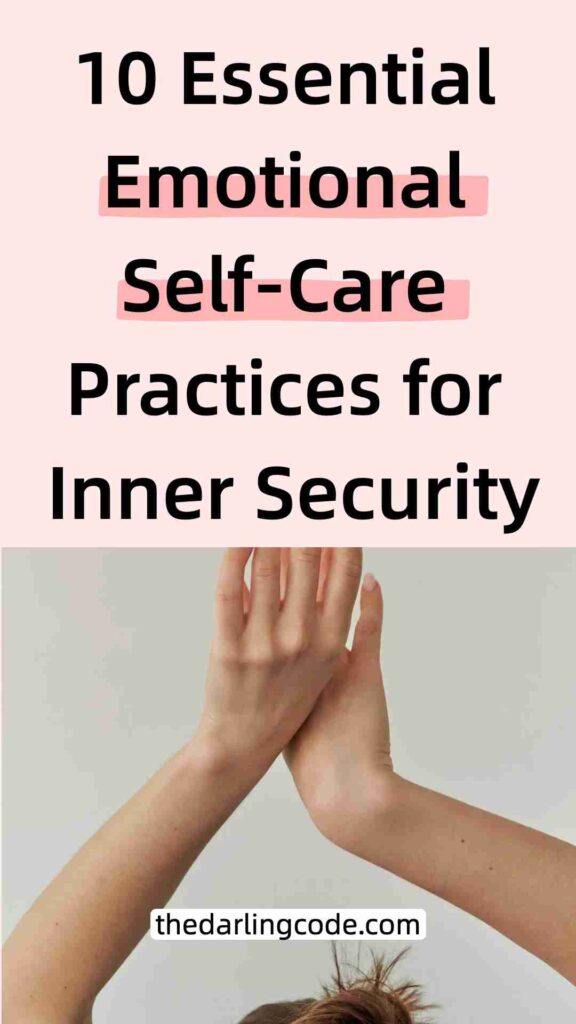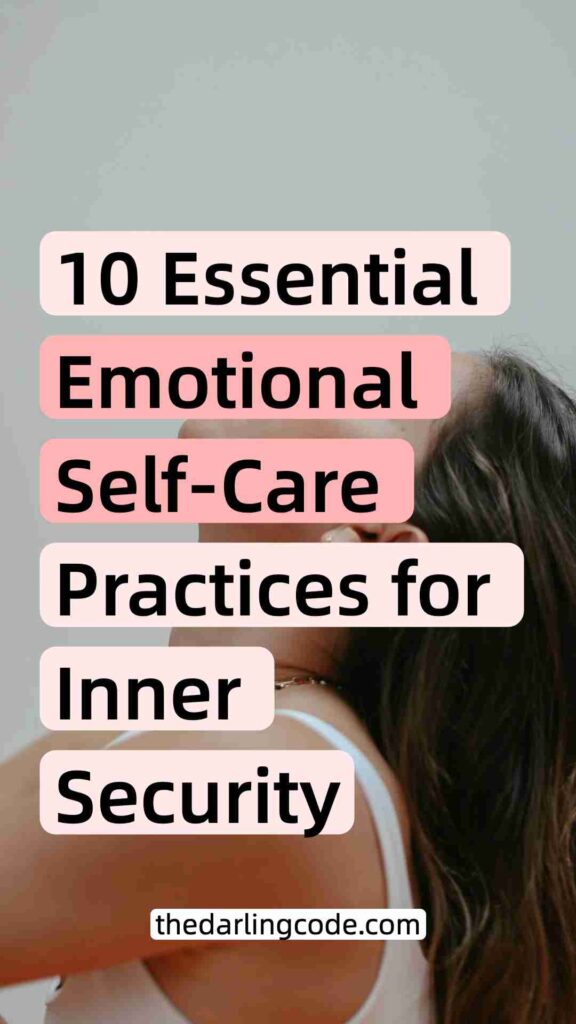10 Emotional Self Care Practices That Build Inner Safety
The experiences shared in this article are based on real emotional journeys, but all personal details are anonymized and used with the explicit written permission of the clients. Any resemblance to actual persons, living or dead, is purely coincidental. We are committed to treating all client stories with the utmost confidentiality and respect.
You know that feeling when you’re scrolling through your phone at midnight, your chest tight with unnamed worries, wondering why everyone else seems to have their emotional ducks in a row except you?
I’ve been there—curled up on my couch with chamomile tea gone cold, replaying a conversation from three days ago, thinking, “Why does connection sometimes feel so hard?”
As someone who’s spent years guiding women toward healthier relationships (including plenty of late-night client calls and my own messy learning curves), I’ve realized one universal truth: inner safety isn’t about avoiding discomfort—it’s about knowing you can trust yourself to handle it.
Let’s talk about how to build that unshakable foundation.
Save this article for later—Pin it to Pinterest and come back when you need it! 📌

1. Name Your Emotions Like You’re Introducing Old Friends
When my client Sarah first told me she felt “blah” after her breakup, I asked her to dig deeper. “What’s underneath the ‘blah’?” Turns out, it was grief, shame, and a flicker of relief—all tangled together. Emotional clarity begins with specificity.
Try this:
- Keep a “feeling word bank” in your notes app (abandoned, tender, hopeful, resentful).
- When overwhelmed, pause and ask: “If this emotion had a name, what would it be?”
- For complex moments, try “I feel ___, because ___” statements (“I feel unsteady because I’m realizing I deserve better”).
Sarah started labeling her emotions aloud in the shower (“Oh hey, loneliness, you’re back”), which helped her stop judging them as “wrong.”
Why it works: You can’t comfort what you won’t acknowledge.
2. Create a 2-Minute “Emotional First Aid Kit”
Last winter, I found myself crying in a coffee shop parking lot after a tough session. Instead of spiraling, I opened a note titled “For When Everything Feels Broken” on my phone. It had three things: a photo of my dog mid-zoomies, a voice memo of my niece laughing, and a list of tiny comforts (“peppermint tea, fuzzy socks, that one Halsey song”).
Build yours:
- Collect 3–5 sensory anchors (a scent, song, texture).
- Save them where you’ll actually use them (phone, purse, car).
- Test-drive them before crisis hits.
Pro tip: Include one “emergency reset” action—like splashing cold water on your wrists—to short-circuit panic.
3. Practice Boundary Triage
Boundaries aren’t just about saying “no.” They’re about protecting your capacity to say “yes” to what matters.
My client Emily struggled with a friend who’d text her 2 a.m. rants. She crafted this reply: “I care about you, but I can’t be present for these conversations after 9 p.m. Want to talk tomorrow morning?” Simple, kind, firm.
When overwhelmed:
- Physical: “I need to sit down while we talk.”
- Time: “Let me think on that and circle back Friday.”
- Digital: “I’m muting notifications for the next hour.”
Remember: Boundaries aren’t walls—they’re “I love myself enough to show up fully” signs.
4. Rewrite Your “Should” Stories
We’ve all been gaslit by Instagram captions. “You should be over him by now.” “You should feel grateful.” Let’s retire the word “should.”
Try:
- Replace “I should be ___” with “I wish I could ___.”
- Ask: “Who taught me this ‘should’? Does it still serve me?”
- Forgive past choices (“I did what I could with what I knew then”).
When I beat myself up for staying in a situationship too long, I reframed it: “I was learning how much love I could tolerate. Now I know better.”
5. Schedule “Nothingness” Appointments
Inner safety thrives in empty spaces. Block 15-minute “do nothing” slots (stare out windows, trace your palm lines). One client calls it “rehearsing boredom”—a radical act in our productivity-obsessed world.
For skeptics: Start with 2 minutes of noticing your breath. No apps, no music. It’s harder than it sounds.
6. Talk to Your Younger Self
After a disastrous dating app date (think: him mansplaining my job), I visualized 16-year-old Vivienne—braces, questionable eyeliner, heart full of hope. I asked her: “What do you need me to remember?” She’d say: “You don’t have to prove your worth to anyone.”
How to connect:
- Write a letter to your teen self.
- Keep a childhood photo where you’ll see it daily.
- When making decisions, ask: “Would this feel safe to her?”
7. Master the Art of “And” Statements
Emotional safety means holding space for contradictions. You can:
- Grieve a breakup and feel excited about new possibilities.
- Love someone and walk away.
- Be a strong woman and need help.
Practice: Replace “but” with “and” in self-talk (“I’m scared to speak up and I’m doing it anyway”).
8. Curate Your “Inner Council”
Imagine a personal board of directors for your heart. Mine includes:
- My therapist’s voice: “What’s the kindest choice here?”
- My best friend’s mantra: “Don’t overthink—what’s your gut say?”
- A fictional character (shoutout to Parks and Rec’s Leslie Knope).
Build yours: Whose wisdom (real or fictional) helps you feel grounded?
9. Develop a “Body Yes/No” Checklist
Your body knows safety before your brain does. Notice:
- Yes signals: Relaxed shoulders, deeper breaths, warmth.
- No signals: Nausea, clenched jaw, urge to flee.
A client avoided panic attacks by checking in hourly: “Does my body feel safe right now? If not, what’s one small adjustment?”
10. End Your Day with “Three Truths”
Before bed, name:
- One hard thing you survived today.
- One beautiful moment (even tiny: “the way sunlight hit my desk”).
- One way you showed up for yourself.
This ritual became my lifeline during my Saturn return era—proof I was growing even when it felt invisible.
Final Words from The Darling Code
Inner safety isn’t built in grand gestures. It’s the daily act of whispering: “I’m here. I’ve got you.”
Start with one practice that feels like a soft exhale—maybe naming emotions or scheduling nothingness. Progress over perfection, always.
With heart,
The Darling Code
P.S. Save this to your Pinterest “Self Care” board, then try the “Three Truths” ritual tonight. You’ve already survived 100% of your worst days—this one’s no exception.
Got value from this article? Pin it to Pinterest for easy reference and help others discover it! 🌟


ABOUT THE AUTHOR
Vivienne, Relationship Coach & Self Love Coach
Vivienne is a Relationship Coach and Self-Love Coach who believes the key to great relationships starts with YOU. She helps individuals and couples build confidence, set healthy boundaries, and create connections that truly honor who they are.






